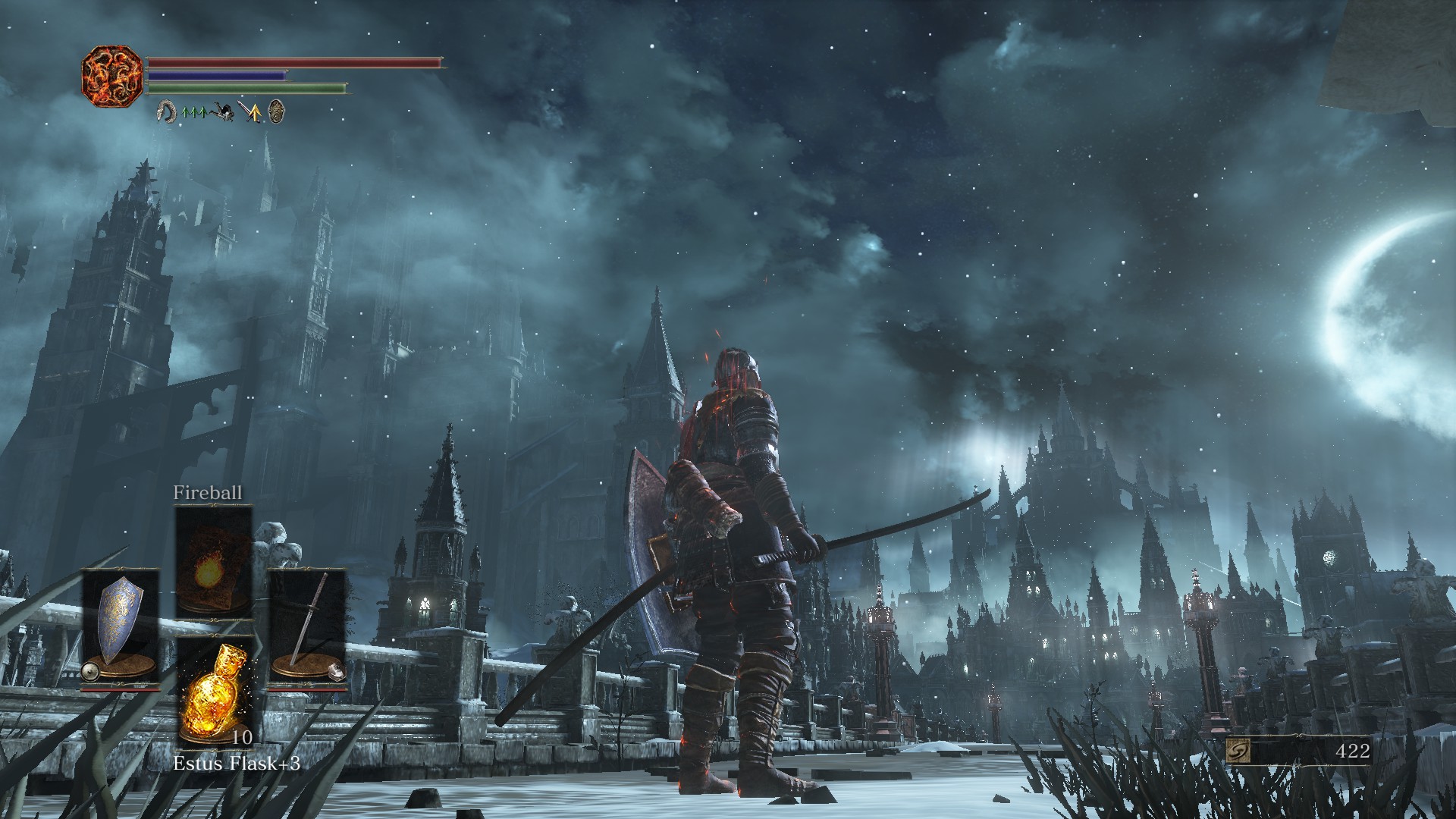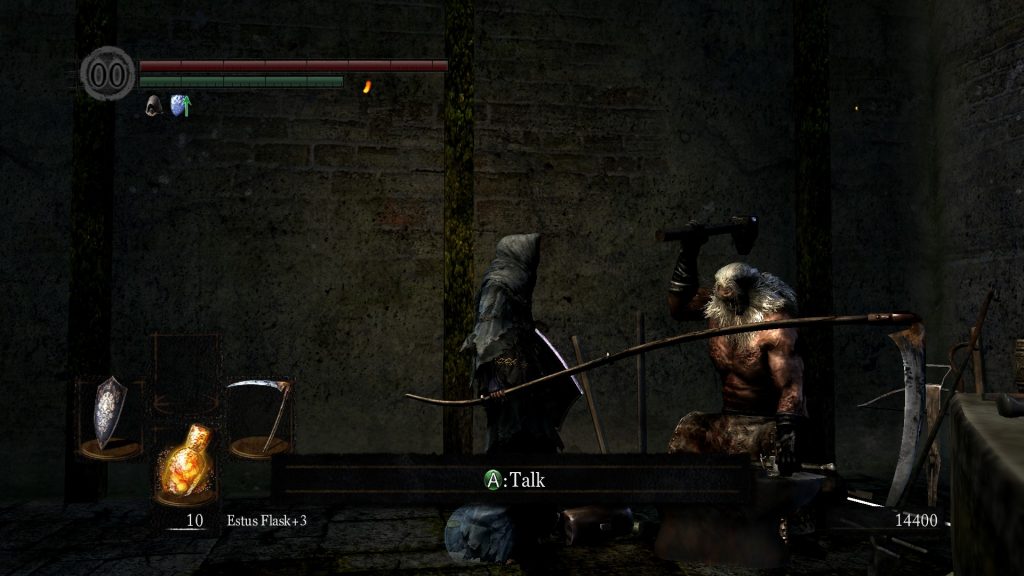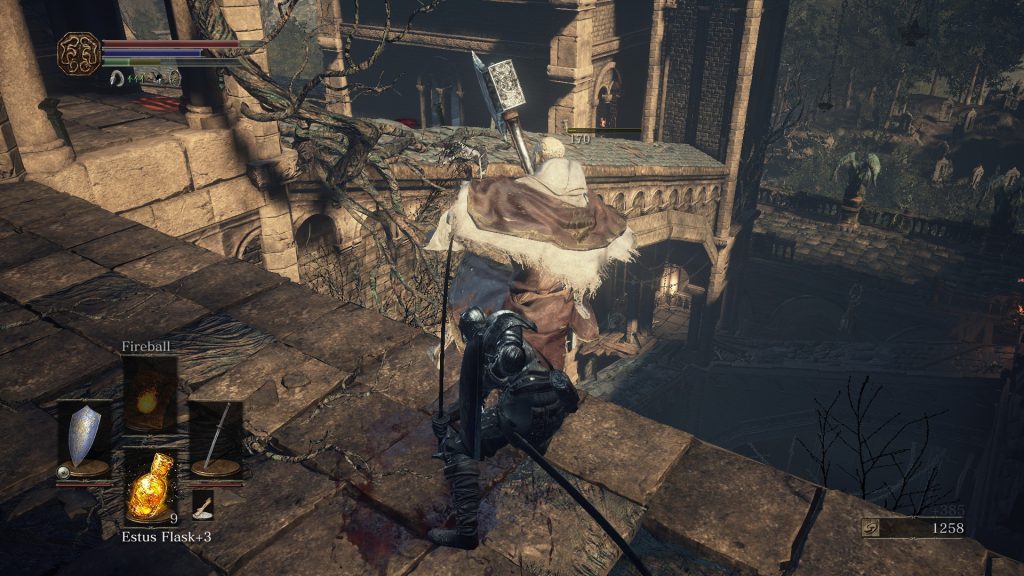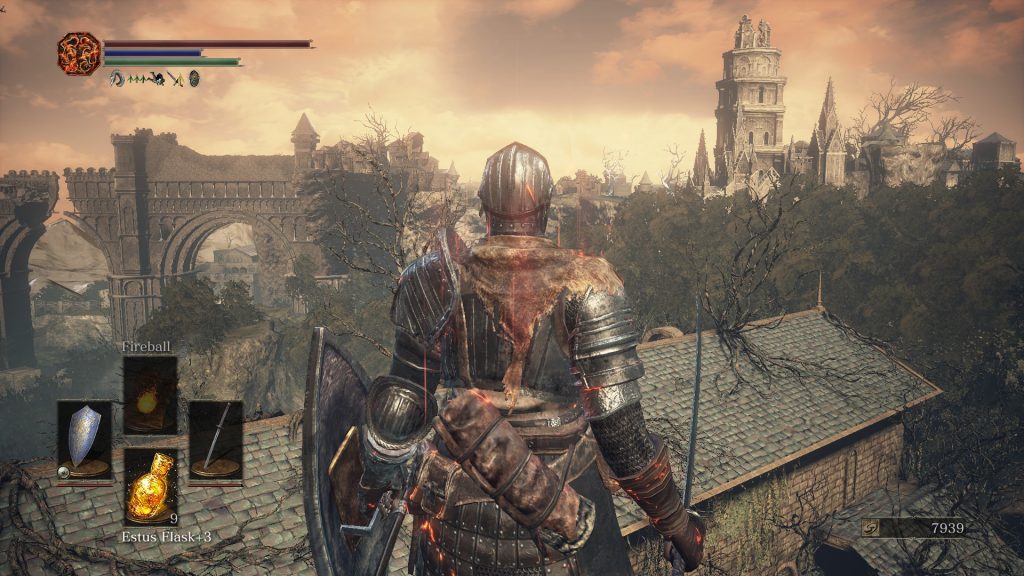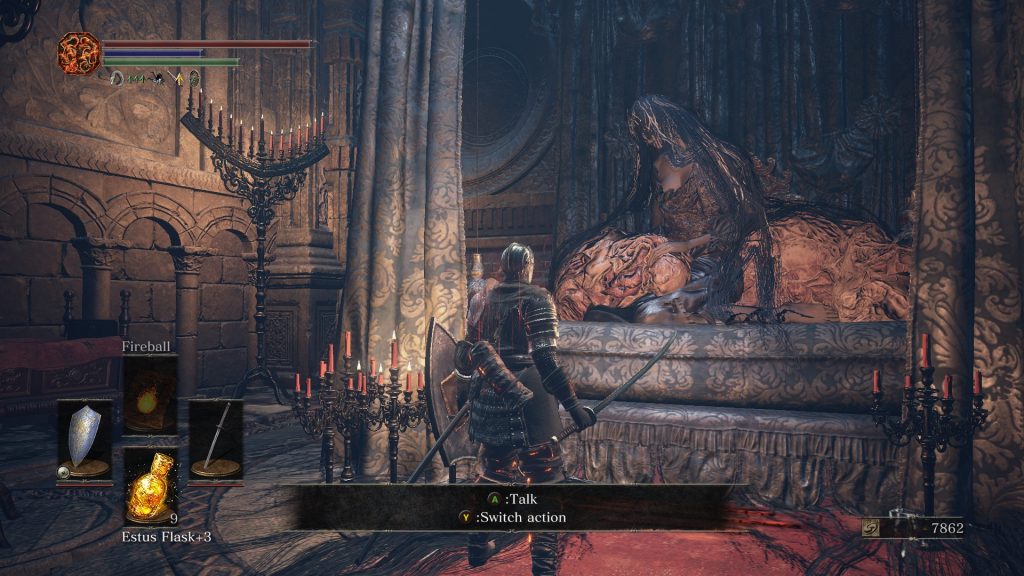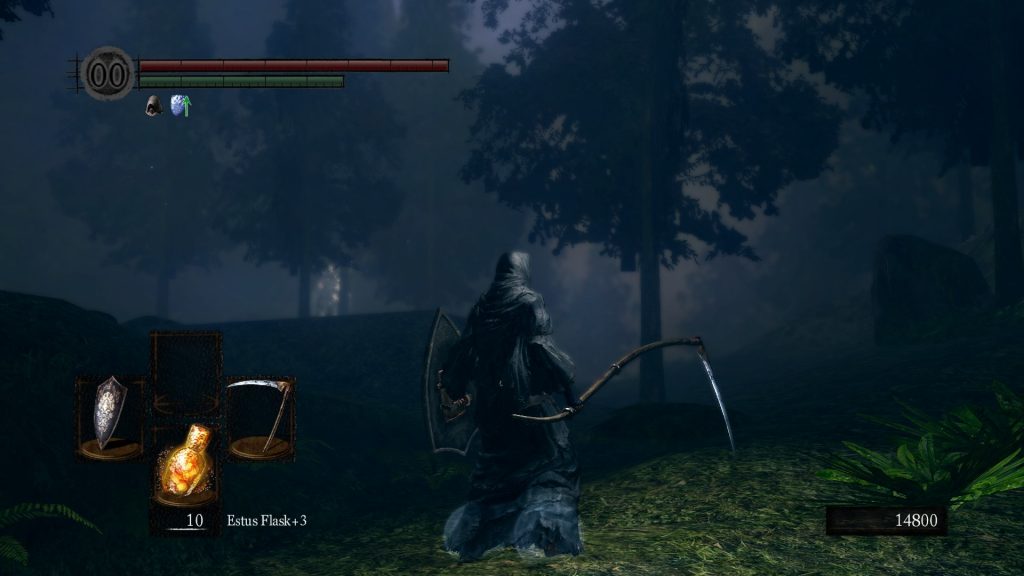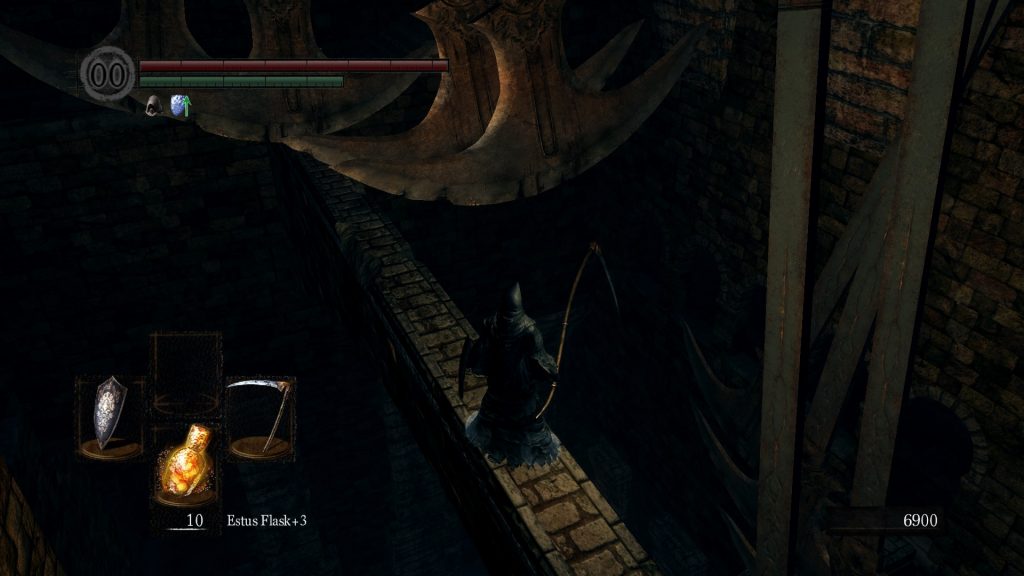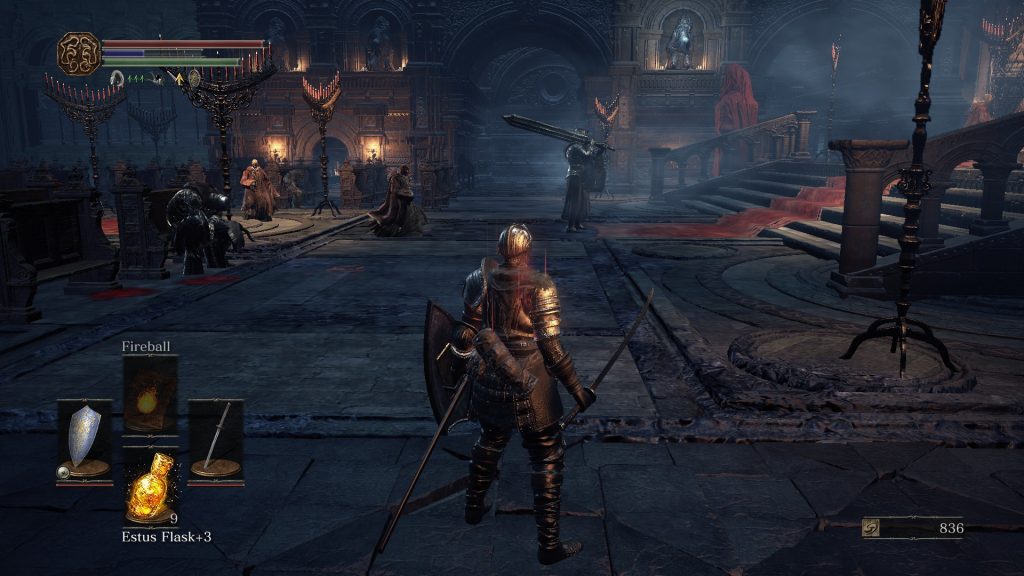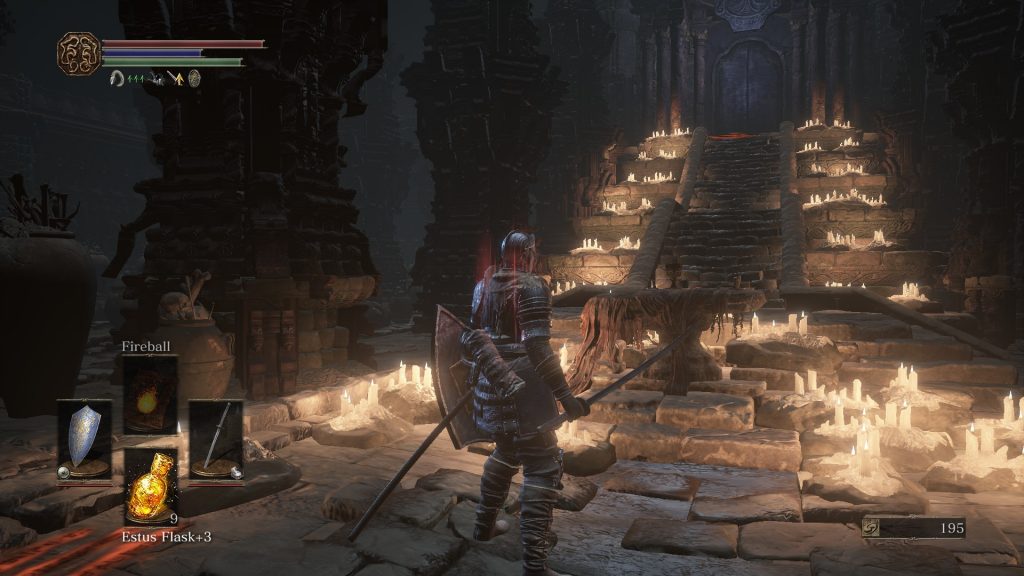Dark Souls is my favorite game series. It’s good enough that even disliking Dark Souls II as much as I do doesn’t unseat it (the Valve-verse of Half-Life and Portal would likely be my second). I first heard about it in probably much the same way you have: that it is a remarkably difficult game with a fanatical fanbase. And also like many, I avoided it because I had heard it was so difficult. It was only when Chezni suggested that we co-op some parts of the game that I started playing. And I died. A lot. I hated it. I thought it was an unnecessarily difficult game – only fun for people who play all their games on hard mode. I preferred wandering around Skyrim, getting lost, and filling my quest log with a laundry list of dungeons to clear – why would I want to play a game that just wasn’t fun?
Slowly, though, I progressed. I learned about dropping from heights to deal more damage. I threw myself against the Asylum Demon until I beat it through a combination of luck and Chezni’s advice. I fought, inch by inch, through the Undead Burg. I figured, to borrow from Zero Punctuation, that “I’ll just keep tanking the rakes and maybe I’ll somehow become really psychotically into being rake-faced […] and I’ll be blatted in the face with rake if that isn’t kind of what happened.” It may have taken me half of the original Dark Souls, but eventually I found myself having fun. A lot of fun. So much fun that I kept coming back even after having beaten the game to play through on NG+. Later, Chezni and I powered through the first few hours of Dark Souls III, which turned out to be just as good as the original (I’m intentionally omitting Dark Souls II in this statement, which I’ll get in to later). So why did I change my mind, and why should you?
An Overview
We’ve talked about this before, but I think Dark Souls is a perfect example of everything a good game should be. From the combat to the level design to the lore, Dark Souls is simply well-crafted. The combat is probably the easiest to praise – it being what Dark Souls is famous for – challenging, precise, and engaging. The twining level design lends itself to the exploration components – allowing you to get lost as you explore a new area, encouraging you to check every corner for secrets and items, and later giving way to an optimal path that your exploration either reveals or opens up. Along these paths of exploration, and back at your main hub, you encounter the occasional fellow lost soul. Almost all of these are helpful – with one notable exception – because at the end of the world the only true enemy among humanity is hollowing.
Hollowing is humanity’s fate. The light of the world is going out and the curse of the darksign has fallen on humanity. The accursed can no longer die – doomed to walk the land as undead and eventually losing their minds – hollowing. Except for you, the player, hollowing is inevitable and seemingly irreversible. All that can be done to prolong the inevitable is to find a purpose and pursue it. For some, this purpose becomes a quest for glory. For some, revenge. All will fail – or worse, succeed: since once you have fulfilled your purpose, hollowing follows. You, the chosen undead, have been given a mission to link the fire – bringing a new age of light to the world and ending the curse. Along your path lie those who have come before you or those who have already succeeded in their quest – each bringing a unique story.
I should put a slight disclaimer at this point. After writing that last paragraph, I went and watched this video. I highly recommend it, but I also recognize that it will influence my own writing after this point. Most of the points in that video I had come up with independently, but the phrasing of my later points may now reflect it too closely for me to feel comfortable writing about without a disclaimer.
The Combat
It’s worth considering what makes Dark Souls combat so good. I believe it comes down to this: your skill in the game is far more a function of your own abilities than it is about what equipment you have or how good a weapon you have. This is made painfully obvious when you are working your way through an earlier area. Even with upgraded equipment, you’ll find that old enemies can still kill you in three or four hits if you aren’t defending or dodging. Yet if you pay attention, you’ll find those earlier areas far, far easier than they were when you first entered. Your own damage output will likely have increased quite a bit, allowing you to kill most enemies faster (meaning you’re spending less time per enemy) – but it’s still a challenge. That’s probably the best part of Dark Souls’ combat. When you die (or even get hit), it’s almost always your fault. You can’t blame bad mechanics or bad controls – it’s all resting on your skill.
That, too, is what makes Dark Souls so notoriously difficult. You enter a game with expectations of difficulty – of being allowed to be careless. You may be lulled by the lock-on targeting removing aim as a factor for close enemies. Instead, Dark Souls demands excellence. Not perfection – perfection would be both impossible and unnecessary. Many other modern games have harder modes where perfection is the only path forward. But perfection isn’t fun when it is compelled. Dark Souls simply demands that you git gud.
This is where I must disagree with Yahtzee of Zero Punctuation (and most other people who have reviewed Dark Souls): a frequent complaint is that it does not ease the player into the game. That there is such a learning curve, and that making the game easier at the start would allow more people to get into it. But I would argue that it would be impossible to remove that learning cliff without removing precisely what Dark Souls is: a game where the skill is invested in you, the player, rather than your character. You, the player, are the one who levels up – not your character. So instead I would encourage you to find someone you know who plays Dark Souls and ask them to play through the first bit of the game with you. That’s how I did it – and having someone around to advise you or to point you in the right direction makes learning those skills much easier.
The Open World
Dark Souls is the open world game I have asked for before: a game where the developers let you miss things in the world. An open world where there are truly undiscovered things awaiting you. Perhaps it goes a bit too far – there are two entire sections of the first game that I missed entirely on my first playthrough; and I never did find the DLC. On the other hand, it balances this obscurity with the messages left by other players – bloodstains, echoes, and clues (of weal and woe) so you can at least find some of them.
The world design of Dark Souls cannot be given enough praise (though here I once again agree with Yahtzee – there is such a thing as too many cathedrals). The far-off distant places are (mostly) all places you will go at some point. As you find your way through the world, you uncover new paths that lead you back to previous areas. The entire game becomes this sprawling, interconnected world that feels vast, yet familiar. I was showing Dark Souls to a coworker when they asked where the map was, and I was momentarily confused. For a moment, I had entirely forgotten that there wasn’t a map – it was all layed out clearly in my head.
Secrets lie in every nook and cranny – and you are encouraged/forced to find them since the path to the next area might also be in a strange, neglected corner. In short, it inspires a sense of exploration while not feeling empty. Something other games fail spectacularly at (why yes, I did just go there). I am perhaps being too harsh on other games here, but I do want to stress the “busyness” of Dark Souls.
The Tone
All that may make this next statement sound paradoxical: Dark Souls produces a fantastic sense of aloneness and of a despairing and dying world. The trick is this: though the world is filled with places to go and things to do, there are precious few other people. There are 38 NPCs in the first Dark Souls, a 60-ish hour game. Several will likely not survive your playthrough. One is a cat. One is a drider. One is…whatever the hell these are. You get the idea. When you meet someone thing that can talk, it’s a big deal. This specialness is compounded by the personalized questlines that many characters have. Each is driven by something that keeps them from going hollow. Your influence matters – and more often than not (unless you read the wiki), that influence may not turn out the way you expected. You are alone: not because the world is empty, but because the only contact you have is with phantoms from other times and other places.
The sense of this game is of a dying world and a despairing land – and the difficulty can lend itself to making the player feel exactly the same way. The perpetual cycle of death and loss can wear the player down, mirroring the character’s own descent into hollowing. It’s hard to say if the immersion creates this parity in feeling between character and player, or if the parity in feeling deepens the immersion. I would argue that it is the mirroring of feeling that deepens the immersion; and as long as the balance between success and failure is kept, the game feels good.
Only a few times does this break down – perhaps the most notable example for me right now is the Abyss Watchers fight in Dark Souls III. At that point in the game, you are at an area where some of the toughest enemies yet are in every direction: the Abyss Watchers, Darkwraiths, Crystal Lizards, Lycanthropes, Giant Crabs, and a Black Knight. This makes continuing to play quite difficult – even a few attempts can wear down your will rapidly.
The Lore
This is the section I can do the least justice, since the lore is the hardest part to get right in the first place. I’ll limit myself to saying that the lore of Dark Souls is such that you can either confront it or ignore it. It is told in half-remembered stories and decaying fragments. It is more implication than statement. It doesn’t feel right to call it a story – it deserves only the title of lore or myth. That video I mentioned earlier has a story of why it is this way – that Hidetaka Miyazaki (the creator) grew up not knowing much English but loving Western Fantasy. Then he apparently decided to outdo us all.
Again returning to immersion, there are two quite standard tools of RPGs missing from Dark Souls: the map/compass and the quest log. Because Dark Souls is so well-designed, the lack of these tools is not an issue and in fact increases immersion. As I mentioned before, there are a very limited number of NPCs in Dark Souls. Their related quests are quite simple and are worked into the gameplay itself – making both the NPC and the quest feel like a natural part of the world. So instead of long-winded exposition, most of the lore comes from item descriptions – each item hints at a larger story, and it is likely not until several playthroughs (or a trip to the wiki) that you would find and read each one. These elements all come together to craft a fantastical world with a Western aesthetic and an Eastern sensibility: a fusion cuisine in video game form.
Now, if you aren’t already tired of me rambling on about Dark Souls, I’m now going to take a look at each game individually – starting with the (almost) original: Dark Souls: Prepare to Die Edition. Technically, both Demon’s Souls and the standard edition of Dark Souls came first – but I’m ignoring those because I haven’t played them.
Dark Souls: Prepare to Die
Dark Souls is far from a perfect game. There are strange physics issues (though none too jarring), large sections that feel rushed or unfinished, and far too many falls to a quick death. At the same time, at least one of these issues is part of the charm of the original game (falling to your death). Chezni perhaps said it best: that the original Dark Souls is perfect in its imperfection. The terrible depths of Blighttown test your resolve. The horrible tightrope ceiling walks and dragon arrow archers in Anor Londo steel you. Beating these areas gives you a sense of triumph – it makes you feel that somehow you have beaten more than was expected of you.
Dark Souls III is more refined in almost every way – but Dark Souls has a certain charm and feeling to it that isn’t as present in III. Much of this likely comes from the original’s advantage of novelty. The world was dark and mysterious, full of strange beasts (and the occasional familiar face). No sequel can ever recapture the complete sense of awe and wonderment in quite the same way that an original can, since the rules of a new world are still being revealed.
Dark Souls III
Dark Souls III is a masterpiece. Mechanically, I feel like Dark Souls III is the game Miyazaki and his team set out to make in Dark Souls. Almost every aspect of combat is better (except for poor poise). The enemies are clever, more varied and have more attack patterns. The environments are sublime (though, as mentioned before: too many cathedrals). It is so tightly crafted that Chezni found it hard to stay immersed in the world when he kept thinking “oh! that’s well-designed”. I didn’t find this a problem, though I did have a few moments where I smiled just because of how well something was put together.
It isn’t as interconnected as the original, and has a much greater “forward momentum”. That is, the game feels much more like you are travelling towards something (because, well, you are). This is most apparent from the moment that you discover that Firelink Shrine is entirely separated from the rest of the game – which also means you have the ability to fast-travel from the start. That being said, there are the occasional moments where you go through a door and find yourself back at a previous area, and it feels like classic Dark Souls again.
If I had one complaint, it would be that the higher order gameplay loop isn’t broken up enough. Let me explain: you come to a new area. You explore the area, trying to find the next bonfire. Once you have found one or two bonfires, you run across a boss. You fight the boss by finding the optimal path from the nearest bonfire to the fog gate. You beat the boss and find the path to the next area. Rinse, repeat. This may sound general, but it has a definite impact on how you play the game when you can clear an area and never have to worry about passing through it again. The challenges that exist in that area only matter as long as I can get to the next bonfire. In the image I used for this section, there is an enemy with a sword quite literally the size of my character. I didn’t beat him – I just ran past to the boss room on the right. I went back later to prove I could beat him, but there was no reason to.
In the original Dark Souls, the interconnected world (and lack of early game fast travel) meant that you would pass through the same area several times – so it made sense to learn how to fight each enemy before moving on. I wish Dark Souls III had had a more hub-like mid-game. This doesn’t mean that it needed to give up its forward momentum. For example, it would have been interesting to descend from the high wall and through the Undead Settlement with the fire keeper, moving from bonfire to bonfire – before finally arriving at Firelink (after fighting the Abyss Watchers, for example) in a more central area. This would remove the need for immediate fast-travel, and Dark Souls worked far better with fast travel as a reward for proving that you could make your way around without dying.
Dark Souls II
You may be thinking: wait – What happened to Dark Souls II? He missed one! Well, I didn’t forget II, but I felt that III and the original needed to be handled together – they fit together far better and (in my opinion) would work well as a duology. Dark Souls II is my least favorite of the series, primarily because it feels so unlike the other two games. That’s not to say it is necessarily a bad game. Honestly, my opinion is terribly biased because of how good the first game was. Before playing Dark Souls III, I didn’t think it would be possible to make its equal. But Dark Souls II has issues: three that I want to address.
First are the less interesting enemy and boss types. While undead comprise most of the population of the Souls universe, both Dark Souls and III vary these enemies in interesting ways. Dark Souls II doubles down on the undead humanoids and suits of armor. Humanoids are boring. Gaping Dragons and the Pus of Man are far more memorable.
Next is the impermanence of enemies. In Dark Souls, all enemies respawn when you rest at a bonfire…except in Dark Souls II, where the enemies will stop respawning after you kill them enough. Initially, this seems like a good deal – you can just kill a particularly tough enemy blocking your path 10-15 times and never have to worry about it again – a corollary to being able to fast-travel past areas in Dark Souls. For me, though, it was a ticking clock. I didn’t do so well at the beginning (for reasons outlined in the next paragraph), and I was really worrying about not being able to ever level up, since I kept killing off the enemies in an area without making it back to a bonfire with enough souls to level up. Dark Souls is about exploring, and making you worry about leveling up more than about exploring is a failure on the game’s part.
Finally are the changes to health regeneration. Dark Souls II introduced smaller healing “gems” as an alternative to Estus. At the same time, they made Estus take just a bit longer to use. I think this extended “use” time means that Estus was meant for out-of-combat healing. Unfortunately, I started playing Dark Souls II immediately after the first game and spent far too much time relying on Estus as my primary means of healing (since that was the only option). This problem was compounded as I tend to avoid using non-renewable resources in games as much as possible. Similar to the respawn changes, having a limited number of useful healing items created the sense that I was running out of time, and presented the very real threat that I would waste a bunch of healing items for no reason.
This problem is compounded by the final HP change: each time you die, a little bit of your health is taken away. The only way to recover this health is to use a Human Effigy (what was Humanity from the first game or Embers from III). But as you may have guessed, these items are also limited. While the health degradation is capped at 25%, this added pressure isn’t appropriate in a game about striving against something again and again. Dark Souls III revealed a similar mechanic, but the health was added to your character after beating the first boss and disappeared entirely after one death. Instead of seeming to slowly punish you for failure, Dark Souls III gives you a temporary bonus for triumphing. Mechanically, this works out much the same, but the way it is presented in II is entirely antithetical to the notion of infinite retries.
These changes create the sense that, at some point, you could find yourself entirely unable to complete the game. And in a very real sense, this deviates from the philosophy of Dark Souls: that you don’t need to be perfect, just good. That you are here to learn and get better. Dark Souls II meant to make it easier for new players – but my playthrough showed a very real issue with the changes they made. New players, if they had initial trouble, would become less and less powerful – making it harder and harder for them to progress.
I am probably too harsh toward Dark Souls II. It is a very different game – and I plan on giving it another shot eventually. It’s entirely possible that I was expecting it to be too much like Dark Souls because the words and areas were familiar, even though the philosophy behind the mechanics was entirely different. Chezni tells me that the game gets a lot easier – almost too easy – once you level up. For the moment, though, this is the only Souls game that I must place into a lower Tier – Three.
Final Thoughts
Few games before Dark Souls had captured my interest in the same way, and I can guarantee that I did not need to apply my efforts as much in any other game. Indeed: before Dark Souls, I generally only played games at the normal difficulty, never straying to the more difficult modes. I think Dark Souls is where I matured as a gamer; instead of playing a game solely for the story or for a mild power fantasy, I played the game for the mechanics and for the challenge. This is not to say that playing a games only for story is a bad thing, but I’d like to compare it to disliking an entire cuisine: it is perfectly acceptable to dislike a cuisine like Sushi or Thai food, but it is still worth trying some from time to time. You never know – you might be surprised to find yourself liking something you never thought you would.
Edit: The HBomberGuy Video About Dark Souls II
After writing this review, I went and watched a bunch of videos I stopped myself from watching earlier – including this one. I may add more to this section as I think of things, but I wanted to talk about it briefly since it’s an interesting alternate opinion. He confirms the problem I was having with healing in the game, and has a good argument for enemy types. I am not a huge fan of PvP in the Souls games, and I think that is why I didn’t enjoy Dark Souls II. In much of his defense of Dark Souls II’s combat, hbomberguy claims that PvP in Dark Souls II was far superior and that fighting “guys in armor” with similar skill sets to yourself lent itself to that. I’m willing to concede this point, with the caveat that that is not what I enjoyed about Dark Souls. It’s a different opinion, and that’s okay. Admittedly, I found his attitude a bit self-rightous and felt his attacks on Matthewmatosis’ video (which, admittedly, I haven’t seen) went a bit too far. Actually, he’s really self-righteous – these videos are probably better.
Steam links: Dark Souls, Dark Souls II, Dark Souls III
Also: Woo! 100th (and my longest so far) Post!
Chezni’s Take
The similarities between Dark Souls and the modern Castlevania games are many if not startlingly parallel now that I think about it. I started out with Harmony of Dissonance, but these same general themes that I’m about to describe can be applied to Symphony of Night and any of the ones released afterward. You see, Harmony of Dissonance was initially a “hard” game. I was unfamiliar with the game’s mechanics, controls, themes, strategies and enemies. I struggled to understand how I was best expected to take down each new foe, and while progress was never completely hindered at any given point (save for wandering around the castle trying to find the next plot point) there were some enemies that I would become “stuck” on for a time, as I revisited them in several segments, beginning from the nearest loaded save point.
Finishing Harmony of Dissonance, I found that I loved the game so much that I immediately created a save file and beat it again. Again though, I was unsatiated. I felt that there was so much good in the game that was under-utilized. What if I went through the game only using spells? How about no spells? How about only equipping gear that increased luck? What about a no “Relic” run? What about a run with no equipment whatsoever? I replayed the game several more times, but I began to impose certain restrictions upon myself that required me to approach it and solve problems from a different angle, in addition to making the game harder. Later, as I picked up other Castlevania titles, I would impose similar restrictions, with my most recent (accomplished about 2 years ago) being an un-upgraded Claymore only run in Dawn of Souls.
You see, the Castlevania series from Symphony of Night and onward is not really that hard. This is funny when you think about the original and several of the original’s sequels, considering they were notoriously known for their unforgiving difficulty. Having beaten it 3 times, I can tell you that the original Castlevania game will always be much harder, no matter how many times you play it. So why was I, a challenge-seeker, more drawn to its modern-day counterparts? Well, I think the answer, and its connection to Dark Souls, has something to do with this—we as a human race, consciously and subconsciously, are compelled to impose challenges upon ourselves that no one in the world is asking us to undertake.
We’re a lot smarter than we think we are, you and I. We’re capable of so much more than we’d like to admit. The human race likes to assume (and easily so) that if we struggle with something, that if we cannot perform an action immediately, then we are somehow inept, when the truth is that we simply lack the experience we need. There’s nothing wrong with us as a problem-solving machine—but for some reason we like to blame ourselves that there is. We view these situations as undesirable and as something that should be avoided. And here’s the catch 22; we are constantly self-imposing, creating, these challenges that we “think” we can’t overcome because we like it. It’s what drives us forward. It’s what makes us grow.
Over the last 7 years (with the start of Demon’s Souls) I have had an identical progression of what I can only consider my interaction with the “adult” version of Castlevania. In my Demon’s Souls infancy, I discovered a game that was not only completely foreign, it was brutally challenging. I died at every single turn without a clue as to what I needed to do to succeed. For several hours, I avoided the first shop-keeper in the game because I thought he was an enemy—one whom I was sure would overpower me. I chose wizard and tried winning through magic alone because I did not understand that— “Hey, this is Demon/Dark Souls. Everybody gets their hands dirty and fights with a weapon at some point. You’re no exception.”
Any time I beat a boss, I felt like gently making the game aware that it must have made some error in its calculation, for I was rather certain that I didn’t have the skill or ability or even avatar strength to topple the giants that I faced. But I was wrong and I loved it. Just as described before, I was fully capable of overcoming these challenges. In fact, I was fully capable of over-accomplishing these challenges. I just didn’t want to admit it because the experience thrilled me. I didn’t *want* to have deserved victory, because an undeserved or unexpected victory is exponentially more exciting. I didn’t want victory to make sense, else the challenges would become commonplace. It would become another Castlevania. By the time I picked up Dark Souls 3, it was another Castlevania.
I’ll give each game a paragraph below later, but I can pretty conclusively say that Dark Souls 3 is the best “built” game out of the 4 Souls games, but it is not the game that I had the best “experience” with. To no fault of the game itself, that award goes to Dark Souls (and probably Demon’s Souls, although I only played about 10-15 hours of it), because back then I didn’t know what I was doing. There was magic everywhere I turned. The controls were foreign, strategy was foreign—learning how to kill every single enemy was an accomplishment that made my spirits soar. Here was a game that I was not supposed to win, and so every foot forward felt like an achievement a mile high.
Looking back at the two times I’ve played through the Dark Souls 3 start to finish, I realized that I imposed the same silly restrictions upon myself that I would do in Castlevania. My first playthrough was as a priest with ridiculously heavy armor—not because I liked the stats (I’m not even sure what the stats were) but because I’d always wanted to go through the game as a heavily armored priest. Grabbing an early unimpressive shield and using the simple mace that I had at the beginning of the game, I beat the entire game without ever altering my equipment. Why? *shrug* Because I wanted to.
Recently (about a month ago) I became aware that my LB (left-bumper) button wasn’t working, and as you Souls fans know, that’s your shield button. Figuring that this was as good a time as any to try a run that I’d always wanted to do, I decided to choose the thief class and go through the entire game with nothing but the starting dagger… so I did. And you know what my surprise was? It was a lot easier than I thought. In fact, in some ways it was easier than when I was playing as my heavy-armor, shield-using spell-equipped priest. It was then that I realized that Dark Souls had hit the same level of “difficulty” as the Castlevania series. It was only difficult because I was making it difficult. And when you think about it—it always was that way. I just chose not to see it as such.
When you think about it, when we play the Souls games, the entire experience is one of “making the game difficult on ourselves.” Pyromancers and Knights have always been the “easiest” starting class. So why don’t we always pick them? Why do we pick deprived? Why is deprived even an option? Why are none of the classes “balanced?” It’s because that’s not the point of the game. Deprived exists because the designers knew that there would be those that wanted that sort of challenge. They would want something stupid like a class that starts out with barely anything. True it comes with the reward of being able to manage each and every skill point—but they could have easily done the same with a similar class and given them decent equipment. They didn’t because they knew players love to challenge themselves.
Enemies never have to be killed. This is true in almost every single game. Let me say it again—enemies do not have to be killed. Yet we as players seek and destroy almost every enemy we encounter. Whether it be Zelda, Mario, Doom or Dark Souls; unless the game is forcing you to kill enemies to progress, you do not have to kill everything. Yet we do. A lot. We aren’t satisfied until every last living creature is demolished. We aren’t satisfied until we’ve bested all foes before us and made the locale we are traveling safe. We could just run past them all. We have infinite lives. There will be a checkpoint (bonfire) later on so that we can start there again if we die. Why do we fight everything?
We don’t need to collect every piece of gear. We don’t need to have +10 equipment. We don’t need to grind souls to get those extra 5 levels so we can have those extra 10 damage points from Strength. But we do. Why? Because we want the challenge. We want to overcome it. We want to scour the land finding useless odds and ends trinkets (be honest—do you even use half of the stuff you find in Dark souls?). We want to have the “perfect weapon.” Half of the joy isn’t just the increased damage, but the knowledge that “it doesn’t get any better than this.”
But honestly, as long as your weapon is semi-upgraded you’ll do fine. As long as you’re grabbing the low-hanging fruit from discoverable items you’ll also do fine. You don’t actually need to scour the land for that last ember, or that ring that has some clever effect that you’ll never use. In fact, we could just come back after we’ve progressed a few sections further into the game when the enemies in the current area would be a joke. After all, equipment in the Souls games isn’t really tiered, so most of it would still be useful, even if found at a later time. But again—we don’t; we want to go out exploring and find it now, when it’s harder.
Similar to any of the Megaman games, knowing an enemy’s weakness and attack patterns turns what may have seemed like a difficult fight into a trivial series of button presses—but when we are stuck against a boss, so often we don’t back off, try a different strategy and discover the enemy’s weak point, we just keep throwing our poor undead body at it over and over again thinking “I can beat them with what I have.” Chances are, if we would stop being so stubborn and spend our souls on consumables, we could toxic or lightning or otherwise cheese our way to victory against an “undefeatable boss.” And yet again for the last time—we don’t.
We like to play Dark Souls because Dark Souls lets us challenge ourselves the way we want to be challenged. It lets us get the uber-gear if we want it. It lets us play with nothing but a dagger. It lets us kill every single enemy in the game in a long and bloody ordeal—it lets us run past every enemy to the next bonfire in a matter of minutes. The older I get, the more I’m starting to think that everything in life is like this. I’m wondering if everything I do isn’t part of this subconscious desire to make things difficult so that I feel challenged.
Is anyone but ourselves making us work so hard in our life? Does the universe really create validation in our existence through the overcoming of increasingly challenging obstacles, or do we? After all, by basis of comparison, the things we think are “so important” and “so hard” now, may be trivial later. Or maybe to another person they are useless or valueless. In fact, I would imagine more so than not.
Lepcis and I discuss on multiple occasions the nature of life and video games. We have come to the conclusion (to simplify things) that life is growth and to be perfect is not to be human. If I were to say anything about Demon/Dark Souls that hasn’t been said before, it would simply be this: The Souls games are a perfect simulated playground for life. It is full of obstacles; some of them optional some of them not. It is full of tools—some of them technically “stronger” some of them not. The game, like life, makes no distinction towards those that have overcome some enemies and not others. It makes no distinction whether you have the best gear or the worst. Excluding the multiple-ending variants (which until Dark Souls 3 were actually more dependent on a simple “stay or leave” choice made at the end of the game) anyone who makes it to the end of the game receives the “same” ending. The game doesn’t care how you got there. The world doesn’t care how you got there. But you do. And that’s what matters in the end.
Demon’s Souls
The first game in the series, Demon’s Souls, introduced the concept that being dead (soul form) wasn’t really all that bad. The game was almost arcade or Gauntlet the Legends-like in that you began in a central hub with the option to choose five worlds to visit, each with a linear progression of challenging areas that end with an ultimate boss (Dragon God anyone?). From a personal standpoint, it taught me that “getting gud” was a prerequisite to playing the game, you need to backstab everything that stands on two legs, and hey, wizards can use swords too. It was the first game of its kind to introduce the “phantom” mechanics, whether it be the helpful Blue Eye phantom or the dreaded invading Black Phantom. It’s a pity they had to change the name, because this truly is Dark Souls 1, with all the tricks, stats, mechanics and nuances needed to claim victory and stave off despair that became the series’ backbone.
Dark Souls
Ah, the successor. The one that caught on. The one that finally drew accreditation from the masses and put the Souls series on the map. Dark Souls. For many who had missed Demon’s Souls, this would be the one. The original. An adventure of a lifetime—and it truly is. The mechanics, albeit tweaked from Demon’s Souls are essentially the same at heart with one huge twist: open world. Suddenly it wasn’t enough to journey past a location, it became necessary to scour that location for hidden passages into other lands. The world was topsy-turvey the first time we ventured through it, and during our longest journeys where we thought we were leagues away from our cherished home, we would unlock a door and step through it only to find we were back at Firelink.
Dark Souls accomplishes to a degree what none of the other franchises have managed, and that is providing a relatively non-linear interconnected journey that is somehow clear enough to allow the player to consistently progress, yet hidden so much in the mist that each step is one of uncertain excitement. Boasting some of the more exciting (or at least memorable) characters in the franchise, players to this day mourn their struggles against Smough and Ornstein, swoon over Crossbreed Priscilla and participate in ceaseless sun praising with the loveable Solaire. Dark Souls built the backbone of what was to become the lore of the Souls world, and the two following games would pay homage to it, shaping their stories around it.
Dark Souls truly taught us what it was like to feel despair. Demon’s Souls had a general sense of “Hey, you’re in Soul form. You should probably fix that.” Dark Souls said “Hey. You may look human, but you’re becoming Hollow inside, and if you as a player don’t steel yourself, you will become Hollow too.” It taught us to recognize the strain of overcoming seemingly impossible obstacles and the legitimate toll that it takes, not just on the characters in Dark Souls, but on you as a player as well. For those of us that avoided Hollowing, it taught us to laugh at our mistakes. To embrace the Twinking invaders. To enjoy Jolly Cooperation. And by the end, if we finally managed to lay Gwynn to rest, that victory is not without its consequences, and that possibly—in spite of all suffering—the ending wasn’t the best part of our adventure. It was the journey itself.
Dark Souls 2
Dark Souls 2. Love it or leave it edition. I will admit, I’m more in the latter of the two categories, but there are still some good things to be said about it… so naturally, let’s start with the bad. : )
Gone is the sense of journey, or rather the same sense of journey. The world is technically interconnected, but two pieces of the game make that point irrelevant—immediate fast travel from the beginning of the game, and the enormous scale of the game. Now don’t get me wrong, I’ll be complimenting the game’s massive scale in a moment, but here it is recognized as scale without craft. Let’s take a brief look at what is arguably the “first area” of Dark Souls—the Undead Berg. Even before entering the passageway (aqueduct) to enter the Berg, you are greeted with an archaic staircase built into a mountainside guarded by a set of undead soldiers. I say “guarded” because that’s what it feels like—each soldier feels specifically placed to serve a purpose. The soldier at the bottom has a sword and shield, serving as a bulwark to prevent your ascension up the steps. While you are dealing with him, another soldier above assaults you with fire bombs if you get too close. Likewise, closing the gap (and possibly circling around as you wait for him to drop his guard) is yet another soldier who will drop down off the stairs to assault you from behind while your back is turned.
Defeating these soldiers will grant passage up the stairs so that you can take care of the soldier throwing fire bombs at you. As you approach, you’ll discover a soldier guarding him, which you’ll have to contend with instead of getting a free assault on the fire bomb soldier. This gives the fire bomb soldier enough time to swap weapons and engage you. If you engage the soldier guarding the fire bomb soldier, a third undead will charge down the stairs on your right, executing a leaping attack on your exposed flank. All of this happens naturally, due to clever enemy placement and good AI. These enemies feel real and purposeful. Defeating them is a cinch once you know what to expect and is not stat-reliant; you simply have to play cleverer than the AI and you must know what to expect. Any veteran can easily run up this staircase and dispatch these undead without a second thought, but not so on our first attempt.
Now let’s look at the “first area” in Dark Souls 2, the Forest of Fallen Giants. Excluding the strange bipedal hippopotamus creature (comparable I suppose to the random Black Knights in the Berg) you encounter roughly the same number of undead soldiers on your way up to the first ladder, that ascends into the forest proper. The difference? The placement of these soldiers suggests very little purpose, which ultimately is the problem with Dark Souls 2; scale without meaning. Two soldiers are meandering on the river bank, making themselves easy targets. There is a bonfire right next to them across the river, meaning risk of failure is meaningless. Further on, there are several other soldiers that are also blandly placed on a ridge that ascends slowly, creating a path to the eventual ladder. You will be frontally assaulted by a handful of soldiers that blindly charge at you, while an archer in the distance takes pot-shots. Another soldier lazily clip-falls off a cliff to the right, but it’s not really important—you’re likely already gummed up by the soldiers in front of you, so all it means is one other soldier to contend with.
Enemies in Dark Souls 2 are much more of the “we’re here to get in your way” variety and much less “we present a unique situation that you must use your tools to solve” variety, which ultimately sums up the largest parts of my problem with the game. They just don’t feel real. The scale of the game is huge, and the enemy placement isn’t clever, it’s just “hey we need to fill up this empty area with things for you to kill.” And kill you will. Over and over and over again as you encounter the same exact enemies over and over and over again until you move on to the next area. Not that it matters—I don’t know the actual number, but if I guessed that 90% of the enemies in Dark Souls 2 are bipedal humanoids with weapons (including the bosses) then I probably wouldn’t be that far off.
Gone are the creative tyrants like the Gaping Dragon. Heck, even the Taurus Demon was… well a demon that was Taurus flavored, and not just another guy in a suit of armor. And besides, what made that fight interesting wasn’t the Taurus Demon itself, but the fact that you fought it on a bridge. Likewise, its counterpart the Capra Demon, was only an interesting fight because you encountered it in such a cramped space with two undead dogs. Dark Souls 2 is a stat-based grind-fest, where victory comes from having your stats in the right place and having enough stamina to stun-lock-chew through your enemy’s HP bar. There are other problems that could be touched on (lack of interesting lore, bland characters, a story that makes no damn sense) but let’s move on to the good.
For starters, this game is much smoother. Character movement is more responsive, combat feels less unintentionally clunky, and even menu navigation speed has been greatly improved partially due to its layout. Exploration is still rewarded (although I would argue that the rewards are less exciting, generally reserved to souls or consumable items that you won’t use) and Marjula as a hub is fairly well-built. At first I thought it was shallow, but the more I played the more I realized that there were goodies and secrets hidden around that I had missed during my first few visits.
If you do play this game, steel yourself because it is long. The longest game in the series, this game has you traveling through massive locations spanning bonfire after bonfire and there are a ton of them. If you felt like you didn’t get your fill, the DLC contains locations that are even more massive, including a giant floating castle in the sky that you can explore top to bottom. It took me hours, and I still didn’t find everything. Skills and spells have been expanded upon, and you’ll find a variety of new content that wasn’t present in the first two installments—which leads us to 2’s strongest foundation. PvP.
I personally don’t enjoy PvP in the Souls universe. I find there to be little gained from invading or being invaded, and while it adds a large degree of excitement and uncertainty to the gameplay, I feel it inevitably devolves into a dick-waving contest where those that are insecure about themselves attempt to fool their ego into one of superiority by preying on the weak, unprepared and unwilling. That being said, I have watched my brother spend hours fighting others in PvP combat and it was genuinely fun to watch. He encountered all manners of fighting styles, each with their own dirty trick employed to gain victory. Having little PvP experience in any of the Souls games, I am willing to default to the general consensus of the community that Dark Souls 2 has the best PvP out of the 5 games.
Bloodborne
If Demon’s Souls is Dark Souls 0, then Bloodborne might as well be Dark Souls 2.5. While fans of Dark Souls bit their nails, anxious for another Souls game, Bloodborne was released as a sort of spin-off game. Bloodborne took the sort of passive “circle with shield up and roll” playstyle of the Souls series and threw it out the window, favoring in every way the strategy of aggressive scrappy fighting to the bitter end. How? Simple. There are no shields (aside from the joke shield) and the best method of recovering damage was to do more damage.
Dark Souls 3
This leads us to the most recent installment, Dark Souls 3. Lepcis covered much of what I would say—this is arguably the best in the series. A more aggressive fighting style is favored similar to Bloodborne, but it’s not as mindless as Dark Souls 2 (when it comes to PvE). Enemies are incredibly responsive to the player, to the point where old cheap tricks are a lot harder to pull off. The age-old tactic of “circle around for 30 seconds until you can get behind the enemy for a backstab” hardly works anymore, as several enemies will catch on to what you are doing and smash you with whatever is in their hand that’s nearest to you (be it shield or religious text). Enemy placement is unique like in Dark Souls 1—enemies don’t feel like they were placed to get in your way, the feel like they each serve a unique purpose.
All in all, this feels like the result of nearly 10 years of polish; a game that is solid in every way. Truly, the only “complaint” Lepcis and I continued to bring up is its linearity compared to Dark Souls 1—but even that was mostly forgivable once you discover that there are a few paths you can take in different orders, including the odd-optional area. True, it doesn’t have Solaire. True, its PvP has been remarked as being “unbalanced,” or that poise is dead. But overall across the board checking all the marks, it feels like the superior game out of the 5. Adding in the DLC, it feels almost as long as Dark Souls 2 but with the charm and spirit of Dark Souls 1.
Dark Souls 3 may not be the most unique title out of the bunch, but why would/how can it be? It is meant to be the fullest realized form of the Dark Souls series; one that if it were the last, I would feel satisfied ending on. Tier One easily—with my only complaints being noticeable because when something shines so brightly, it becomes all the easier to notice the odd dead pixel here and there.
